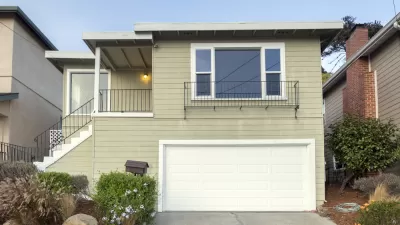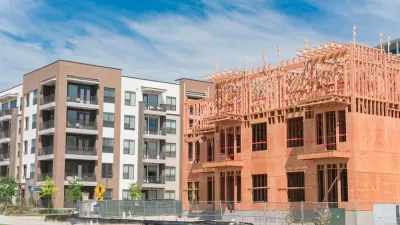A bill to reduce parking minimums for residential or mixed-use developments that include affordable units passed a key Senate committee. AB 744 amends the state's density bonus law, itself controversial, that incentivizes building affordable housing.
AB 744, authored by Assemblymember Ed Chau (D-Monterey Park), Chair of the Assembly Committee on Housing and Community Development, passed the Assembly on June 4 and is now working its way through the Senate. Melanie Curry reports for Streetsblog California on the hearing in its first Senate committee, Transportation and Housing, where it passed 7-4 on July 7.
"The bill, AB 744, would reduce parking requirements for affordable housing developments, making it less expensive to build affordable housing and using federal tax credits to build housing rather than unnecessary parking," writes Curry. "Some of the senators on the transportation committee showed a deep misunderstanding of the effects of parking policies, as well as of the larger purpose of the bill."
Actually, that's somewhat understandable, as this bill only relates to what is called the density bonus which developers may not wish to claim even if eligible.
Density Bonus Law
"DBL was first enacted in 1979 to address the State's shortfall of affordable housing," writes Matthew Hinks of the California Land Use blog. "It does so by offering incentives to developers to include low income housing in new construction projects." Citing a court case, Hinks continues:
"Although application of the statute can be complicated, its aim is fairly simple: When a developer agrees to construct a certain percentage of the units in a housing development for low or very low income households, or to construct a senior citizen housing development, the city or county must grant the developer one or more itemized concessions and a 'density bonus,' which allows the developer to increase the density of the development by a certain percentage above the maximum allowable limit under local zoning law."
Back to AB 744: it amends existing density bonus law (Government Code Section 65915-65918) by targeting two specific (narrow?) types of projects:
- 100 percent affordable that are either a seniors-only development, or a development that serves special needs individuals, located within one-half mile of a major transit stop
Affordable housing developers would not need to provide parking greater than .5 spaces per unit if they meet the above criteria.
- "For mixed income developments (i.e., a mix of affordable plus market rate) units, within one-half mile of a major transit stop that include the maximum number of very low- or low income units under Density Bonus Law the parking requirement cannot exceed 0.5 per bedroom," according to the AB 744 fact sheet.
What does the "maximum" refer to? Scroll down the text of the bill to the chart showing "Percentage Low-Income Units" and corresponding "Percentage Density Bonus."
Controversy over the density bonus law can be seen in a trio of 2008-9 posts about the use of the law in Los Angeles (in "Related" below) that culminated with a judge rejecting parts of a city ordinance based on the state law (SB 1818) at that time.
In a five-part series, Urban One, "a boutique Los Angeles based firm that specializes in the management of complex urban development projects for public and private clients," Shane Phillips "outlines recommendations and proposals for improving the California/Los Angeles density bonus program."
Part 1 focuses on background, while Parts 2 through 5 include specific recommendations to improve the density bonus and affordable housing provision throughout the region.
As the Los Angeles controversy shows, the state law needs to be incorporated into city ordinance to be implemented. A recent northern California illustration for a mixed-used development is reported by Gennady Sheyner in Palo Alto online. The current density bonus law is based on AB 2222, signed into law on September 27, 2014.
"Now it goes to the Committee on Governance and Finance, where it will be heard as soon as next week," writes Curry.
Hat tip to John Holtzclaw.
FULL STORY: Bill to Reform Parking Minimums Passes CA Senate Transportation Committee

Planetizen Federal Action Tracker
A weekly monitor of how Trump’s orders and actions are impacting planners and planning in America.

Chicago’s Ghost Rails
Just beneath the surface of the modern city lie the remnants of its expansive early 20th-century streetcar system.

San Antonio and Austin are Fusing Into one Massive Megaregion
The region spanning the two central Texas cities is growing fast, posing challenges for local infrastructure and water supplies.

Since Zion's Shuttles Went Electric “The Smog is Gone”
Visitors to Zion National Park can enjoy the canyon via the nation’s first fully electric park shuttle system.

Trump Distributing DOT Safety Funds at 1/10 Rate of Biden
Funds for Safe Streets and other transportation safety and equity programs are being held up by administrative reviews and conflicts with the Trump administration’s priorities.

German Cities Subsidize Taxis for Women Amid Wave of Violence
Free or low-cost taxi rides can help women navigate cities more safely, but critics say the programs don't address the root causes of violence against women.
Urban Design for Planners 1: Software Tools
This six-course series explores essential urban design concepts using open source software and equips planners with the tools they need to participate fully in the urban design process.
Planning for Universal Design
Learn the tools for implementing Universal Design in planning regulations.
planning NEXT
Appalachian Highlands Housing Partners
Mpact (founded as Rail~Volution)
City of Camden Redevelopment Agency
City of Astoria
City of Portland
City of Laramie





























